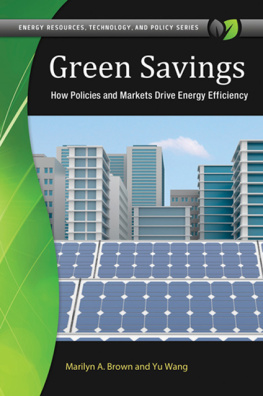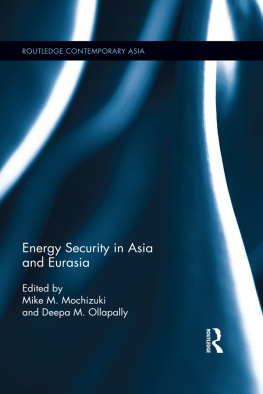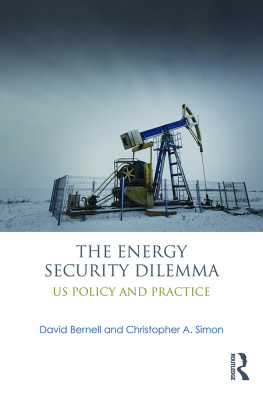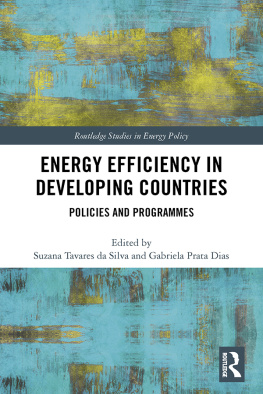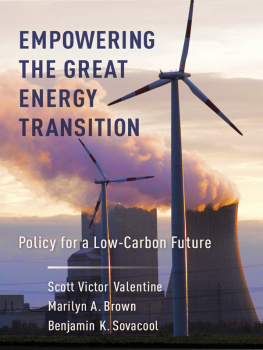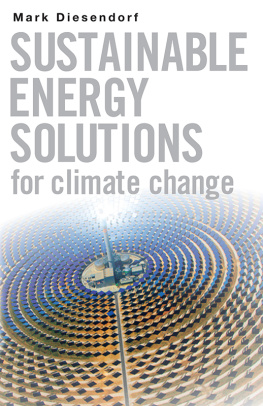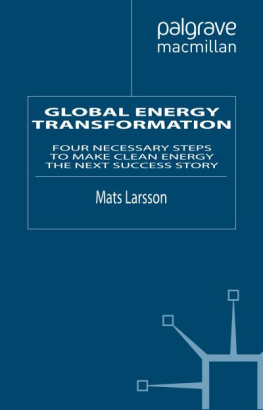
Recent Titles in
Energy Resources, Technology, and Policy
Series Editor: Benjamin K. Sovacool
A Smarter, Greener Grid: Forging Environmental Progress through Smart Policies and Technology
Kevin B. Jones and David Zoppo

Copyright 2015 by Marilyn A. Brown and Yu Wang
All rights reserved. No part of this publication may be reproduced, stored in a retrieval system, or transmitted, in any form or by any means, electronic, mechanical, photocopying, recording, or otherwise, except for the inclusion of brief quotations in a review, without prior permission in writing from the publisher.
Library of Congress Cataloging-in-Publication Data
Brown, Marilyn.
Green savings : how policies and markets drive energy efficiency / Marilyn A. Brown, Yu Wang.
pages cm. (Energy resources, technology, and policy)
ISBN 978-1-4408-3120-1 (hardback : alk. paper) ISBN 978-1-4408-3121-8 (ebook) 1. Energy consumptionUnited States. 2. Renewable energy sourcesUnited States. I. Wang, Yu, 1984- II. Title.
HD9502.A2.B76 2015
333.7917dc23 2015018387
ISBN: 978-1-4408-3120-1
EISBN: 978-1-4408-3121-8
19 18 17 16 15 1 2 3 4 5
This book is also available on the World Wide Web as an eBook.
Visit www.abc-clio.com for details.
Praeger
An Imprint of ABC-CLIO, LLC
ABC-CLIO, LLC
130 Cremona Drive, P.O. Box 1911
Santa Barbara, California 93116-1911
This book is printed on acid-free paper 
Manufactured in the United States of America
CONTENTS
FIGURES, TABLES, AND BOX
FIGURES
Obstacles that Lock in Energy Waste
TABLES
BOX
SERIES FOREWORD
As societies around the world grapple with rising sea levels, melting glaciers, a changing climate, competition over scarce energy reserves, growing collective energy insecurity, and massive fluctuations in the price and affordability of energy services, what could be more important than a series devoted to the analysis of the interactions among nations, societies, and energy sectors? This series explores how human beings use energy, and how their conversion of energy fuels into energy services can affect social structures and environmental systems. It aims to educate readers about such complex topics as the modern use of fossil fuels and nuclear power, climate change adaptation and mitigation, as well as emerging trends in state-of-the-art energy technology including renewable sources of electricity and shale gas. It hopes to inform public debate and policy as humanity struggles with how best to transition to newer, cleaner forms of energy supply and use over the next century.
Apart from investigating innovations in the energy sector, and illustrating the fragile balance between energy development and environmental protection, the series also meets a demand for clear, unbiased information on energy and the environment. Books emerging from the series are accessible to the educated layperson, but the depth of scholarship makes them appropriate for a range of readers, including professionals who work in the energy sector, legislators, policymakers, and students and faculty in such fields as engineering, public affairs, global studies, ecology, geography, environmental studies, business and management, and energy policy.
Books in the series take an investigative approach to global and at times local energy issues, not only showing how problems arise when energy policies and technological development supersede environmental priorities but also demonstrating cases where activists and policymakers have worked with energy developers to find solutions. The titles in the series offer global perspectives on contemporary energy sources, the associated technologies, and international policy responses, showing what has been done to develop safe, secure, affordable, and efficient forms of energy that can continue to power the world without destroying the environment or human communities.
The series ultimately shows the progress of energy developers and environmental advocates toward sustainable resolutions. For that, I hope the pages to come excite and challenge you as much as they have me.
Benjamin K. Sovacool
Series Editor
ACKNOWLEDGMENTS
The authors wish to thank the many individuals who helped make this book happen. At Oak Ridge National Laboratory, Dave Bjornstad, Roger Carlsmith, Bill Fulkerson, David Greene, Eric Hirst, Tony Schaffhauser, and Bob Shelton joined Marilyn Brown in pioneering the debate about which technologies, markets, and policies could most effectively improve U.S. energy productivity. At the Georgia Institute of Technology, Paul Baer, Erik Johnson, Dan Matisoff, and Doug Noonan used principles from neoclassical and ecological economics to push for greater precision and clarity when describing the energy-efficiency gap. The current generation of energy-efficiency experts at Oak Ridge National Laboratory (including Melissa Lapsa and Roderick Jackson), the colleagues at the U. S. Department of Energy, U. S. Energy Information Administration, International Energy Agency, the American Council for an Energy Efficient Economy, the Alliance to Save Energy, and the Southeast Energy Efficiency Alliance have kept us apprised of the many opportunities for science, technology, markets, and policy to reduce energy waste. Youngsun Baek, Jess Chandler, Matt Cox, Ben Deitchman, and many soon-to-be PhDs of the Climate and Energy Policy Laboratory at Georgia Tech provided a steady stream of fresh perspectives about the energy-efficiency enterprise. Joe Hoagland and many others at the Tennessee Valley Authority provided a real world sounding board for ideas about the role of energy efficiency as a utility resource. Katherine Southworth (EMVEnergy Solutions, LLC) and Daniel DArcy (Georgia Tech) provided excellent editorial comments and input. And last but not least, we are enormously indebted to Elizabeth Hyman (Georgia Tech), who assisted with graphics and word processing. Funding from the Ivan Allen College of Liberal Arts and the Brook Byers Institute for Sustainable Systems at Georgia Tech is gratefully acknowledged. Any errors of omission or commission in this book are entirely the responsibility of the authors.
INTRODUCTION
This book describes a dilemma wrapped in a paradox. The paradox is that the world needs to reduce its greenhouse gas (GHG) emissions, yet clean and competitive energy-efficiency practices are struggling. That creates the dilemma: will markets and society embrace the opportunity to be part of the climate solution by reducing its consumption of fossil fuels, or will they continue on the currently unsustainable trajectory?
In searching for affordable electricity options that also reduce GHG emissions, energy efficiency often rises to the top of the list. Yet it also has its skeptics and naysayers. Climate policy discussions are trying to balance the urgent demand for quick action with the high upfront capital investment of technological transitions. Energy efficiency is in the center of this debate because there are so many conflicting views about the role it might play and the investment costs it might require.
Advocates have claimed that energy efficiency is cost-effective and indeed might offer negative costssaving consumers money while also reducing GHG emissions. As physicist Amory Lovins once put it, the positive savings mean that energy efficiency isnt just a free lunch; its a free lunch you get paid to eat. The problem is that investments in energy efficiency are made difficult by significant market failures. Once the market imperfections are corrected, energy efficiency will manifest itself as a valuable investment option with high positive returns in capital markets.
Next page
